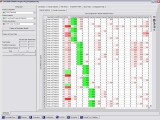Training

During the system's training process all the parameters, which are necessary for a correct attribution of classes to spectra by the system,
are determined and optimized automatically. The result of this process is a so-called "Recognition Module" which can be used afterwards to
identify the classes of new spectra of unknown samples.
The training process consists of three subsequent steps: Feature Computation, Feature Selection, and Classifier Construction.
For each of these steps, the user selects from a series of different methods.

1. Feature Computation
Here, a number of small spectral regions is determined, which might be useful for solving the given classification problem.
These spectral intervals are called
"ROIs" ("Regions of Interest"). For each ROI, one number is calculated
per spectrum (serving as feature value). Depending on the selected method, special measures for the distances between
spectra and class mean curves might be added. The number of feature values calculated for each spectrum during this process
ranges between 100 and up to 500. If the user has provided additional data to be used for training the system, these values
are also added to the list.

2. Feature Selection
Not all of the feature values calculated in the previous step are actually useful and necessary for setting up a powerful
classification system. In this second step the system tries to select as few of them as possible and as many as necessary.
The resulting selection of spectral features, which have been found to be useful for solving the given problem, might provide valuable information
about the chemical, biological or medical background and should be
analyzed by the user at a later time.
Feature selection is a very difficult task, which demands considerable computational expense in many cases.
PATTERN EXPERT airspect
offers a variety of different methods. These include sequential adding or removal of single features,
scoring methods (also called ranking methods), as well as evolutionary algorithms (genetic algorithms).

3. Classifier Construction
In this step the actual classifier is built up, optimized, and trained with the given known spectra. After that, it can be used to determine
the classes for unknown spectra. The user may choose the simple and quick "Nearest Centroid Classifier", or an "Artificial
Neural Network" with or without hidden units, which usually achieves better prediction performance.

The training steps described above yield as a by-product valuable information about your spectra's behavior during the various processes.
Inspect the assignment tables produced during the training steps in order to identify those spectra which have been misassigned by the system
exceptionally many times. Recheck the concerned spectra. In many cases, they turn out to be of low quality, possibly noisy, or even erroneously
assigned to an incorrect class by the user.
 Spectroscopy Techniques
Spectroscopy Techniques  Governing Data
Governing Data  Visualization
Visualization 
 Preprocessing
Preprocessing  Additional Data
Additional Data  Training
Training
 Relevant Spectral Locations
Relevant Spectral Locations 
 External Cross Validation
External Cross Validation  Recognition
Recognition  Retrieval
Retrieval  PlugIns
PlugIns 